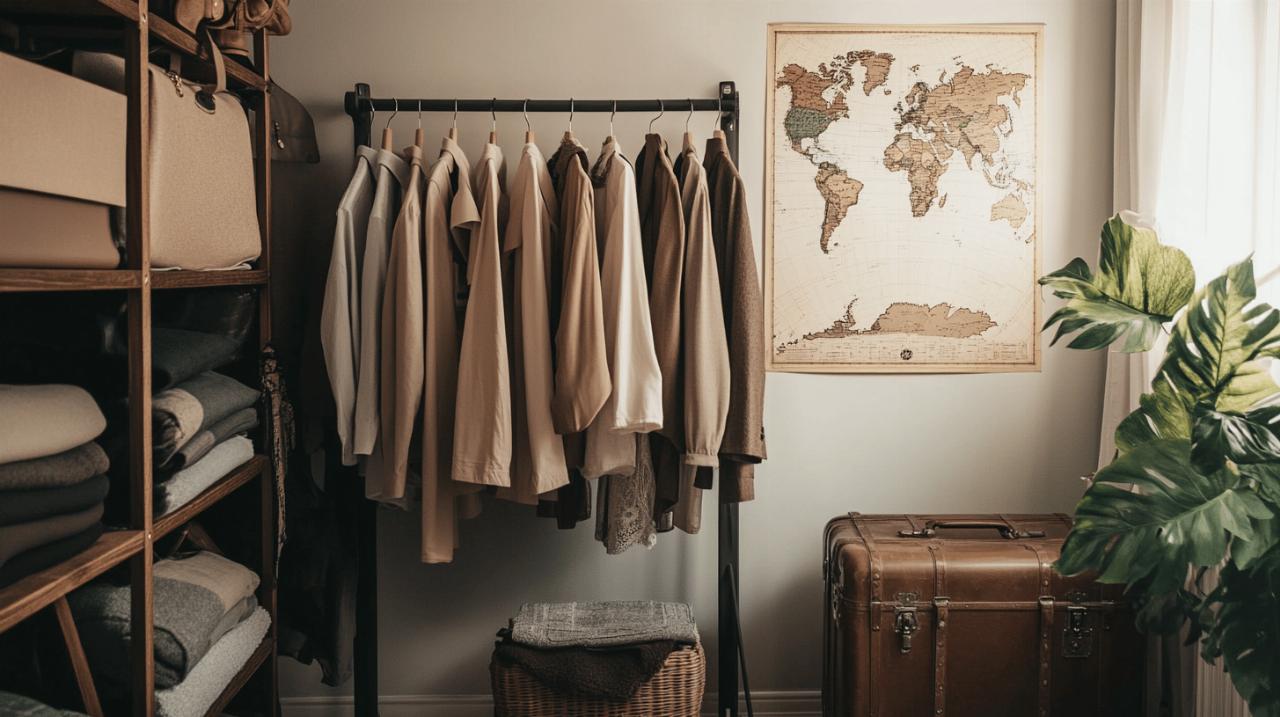Creating a practical capsule wardrobe offers a path to effortless style while simplifying your daily fashion choices. This approach to clothing transforms how you dress, shop, and express yourself through fashion without the overwhelming complexity of a stuffed closet.
Understanding the capsule wardrobe concept
A capsule wardrobe consists of a curated collection of interchangeable clothing items that work harmoniously together, maximizing outfit combinations while minimizing the actual number of pieces you own. This mindful approach to fashion has gained significant popularity among those seeking both style and simplicity.
Origins and philosophy behind minimalist dressing
The capsule wardrobe concept originated in the 1970s with London boutique owner Susie Faux and later gained mainstream attention when designer Donna Karan introduced her 'Seven Easy Pieces' collection in 1985. The philosophy centers on quality over quantity, promoting a seasonless, trendless approach to dressing that stands apart from fast fashion cycles. Many fashion enthusiasts visit places like Monkey Garden boutiques seeking inspiration for their minimalist wardrobes, drawn to spaces that showcase versatile pieces rather than trendy items.
Benefits of adopting a streamlined closet
Embracing a capsule wardrobe yields numerous advantages beyond just looking stylish. This approach substantially reduces decision fatigue each morning, saving valuable mental energy for more important matters. A streamlined closet promotes sustainability by encouraging investment in fewer, higher-quality pieces rather than disposable fashion. The financial benefits are significant too—when you focus on versatile clothing that truly reflects your personal style, you naturally spend less on impulse purchases while building a wardrobe of items you genuinely love.
Assessing your lifestyle and personal style
Creating a practical capsule wardrobe begins with a thoughtful assessment of your everyday life and aesthetic preferences. A capsule wardrobe—a curated collection of interchangeable items designed to maximize outfit combinations—serves as the foundation for effortless style while embracing minimalism. This concept, originated in the 1970s by Susie Faux and later popularized by Donna Karan's 'Seven Easy Pieces' collection in 1985, has evolved into a sophisticated approach to fashion that reduces decision fatigue, saves money, and promotes sustainability.
Evaluating daily activities and clothing needs
The first step in building your capsule wardrobe is analyzing how you spend your time and what clothing requirements accompany those activities. Consider your work environment, leisure pursuits, social engagements, and exercise routines. Do you need formal business attire, casual wear, or something in between? Take into account your climate and seasonal variations that might influence fabric choices. This evaluation helps identify the functional pieces that deserve space in your capsule.
During this process, audit your existing wardrobe to recognize which items you consistently reach for and which remain unworn. Sort your clothing by category to gain visual clarity. This decluttering phase reveals gaps to fill and eliminates excess that contributes to wardrobe chaos. Focus on acquiring versatile, timeless pieces rather than trend-driven fast fashion items. Quality clothing, though initially more expensive, offers better value through longevity and sustainability.
Identifying signature colors and silhouettes
Developing a personal color palette forms the backbone of a successful capsule wardrobe. Select a range of neutrals (black, white, navy, gray, beige) complemented by accent colors that flatter your skin tone and express your personality. A cohesive color scheme ensures that items mix and match effortlessly, multiplying your outfit possibilities without expanding your wardrobe size.
Beyond color, identify the silhouettes and cuts that enhance your body type and make you feel confident. Whether you prefer A-line skirts, straight-leg trousers, or tailored blazers, recognizing these signature styles helps curate pieces that work harmoniously together. Your capsule might include 2-3 pairs of classic jeans, 2-3 pairs of tailored pants, 5-7 versatile tops, 3-4 blouses, and a few well-chosen accessories like minimalist jewelry and practical bags. The goal isn't reaching a specific number—common capsule wardrobes range from 30-50 items—but rather creating an intentional collection that reflects your lifestyle and personal aesthetic while minimizing waste and maximizing style.
Selecting core pieces for your foundation
Building a practical capsule wardrobe begins with carefully selecting foundational pieces that work seamlessly together. The concept of a capsule wardrobe—a curated collection of interchangeable items that maximize outfit combinations—dates back to the 1970s when Susie Faux introduced it, before Donna Karan popularized it in 1985 with her 'Seven Easy Pieces' collection. Creating this streamlined wardrobe helps reduce decision fatigue, saves money, promotes sustainability, and allows you to invest in higher-quality clothing that lasts longer.
When establishing your capsule wardrobe, focus on a neutral color palette that allows for versatility. Most effective capsule wardrobes contain between 30-50 items, though the exact number shouldn't be your primary concern. Instead, concentrate on building a collection that reflects your personal style while emphasizing functionality and timelessness.
Must-have versatile basics for any capsule
A well-constructed capsule wardrobe revolves around versatile basics that can be mixed and matched effortlessly. Start with 2-3 pairs of classic jeans in different cuts that flatter your body type. Add 2-3 pairs of tailored trousers that can transition from casual to formal settings. During warmer months, include 2-3 pairs of shorts and 1-2 skirts that complement your style.
For tops, aim for 5-7 well-made t-shirts and 3-4 blouses that can be dressed up or down. Include 3-4 lightweight knitwear pieces for layering. A selection of 1-2 dresses provides options for various occasions, while 2-3 jackets—including a tailored blazer and a simple trench coat—offer versatility for different weather conditions. Complete your foundation with 3-5 pairs of shoes (loafers, ankle boots, and comfortable trainers), 2-3 belts, and 2-3 practical bags.
Quality considerations when investing in staples
When building your capsule wardrobe, prioritize quality over quantity. Investing in well-made, timeless pieces saves money over time as they won't need frequent replacement. Examine garments for solid construction—look for reinforced seams, quality fabrics, and proper finishing that indicates durability.
Consider fabric composition carefully when selecting your staples. Natural fibers like cotton, wool, and linen typically last longer and age better than synthetic alternatives. Pay attention to care instructions; garments that require special cleaning may cost more to maintain but often offer superior longevity.
Filling gaps in your wardrobe presents an opportunity to embrace sustainability. Explore second-hand stores for unique finds that add character to your collection. When purchasing new items, research ethical brands that align with your values. This approach supports sustainable fashion practices while building a wardrobe that feels authentic to your personal style.
Building seasonal adaptability
Creating a practical capsule wardrobe requires thoughtful consideration of seasonal changes. A well-designed capsule wardrobe emphasizes versatility through carefully selected pieces that work year-round, reducing the need for complete wardrobe overhauls between seasons. By focusing on interchangeable items and layering strategies, you can maintain style while embracing minimalism and sustainability.
Transitional pieces for year-round wear
The foundation of seasonal adaptability begins with selecting transitional pieces that serve multiple seasons. High-quality basics like well-made t-shirts, button-down shirts, and lightweight knitwear function as wardrobe staples regardless of weather conditions. Classic jeans, tailored trousers, and versatile skirts create a solid foundation that works throughout the year. When building your capsule, prioritize timeless designs over seasonal trends, and invest in quality fabrics that maintain their appearance through regular wear. Selecting a cohesive color palette—primarily neutrals with a few accent colors—maximizes outfit combinations while keeping your wardrobe focused. Rather than strictly limiting your item count, focus on versatility and functionality, ensuring each piece earns its place through regular use and multiple styling options.
Layering strategies for changing weather
Mastering the art of layering transforms basic pieces into weather-appropriate outfits throughout the year. Start with lightweight base layers that work independently during warmer months, then add medium-weight pieces like lightweight knitwear, button-downs, and blazers as temperatures drop. Strategic outerwear investments—like a simple trench coat for spring showers, a tailored blazer for transitional months, and a quality winter coat for colder seasons—create weather flexibility without requiring separate wardrobes. Accessories play a crucial role in seasonal transitions; scarves, minimalist jewelry, and practical bags can transform outfits while maintaining your personal style. When refreshing your capsule between seasons, focus on incorporating only a few truly necessary seasonal items rather than completely overhauling your collection. This approach reduces decision fatigue while supporting ethical fashion practices by minimizing consumption and maximizing the utility of each garment.
Mixing and Matching for Maximum Outfits
A capsule wardrobe revolves around the art of creating multiple looks from a limited number of pieces. This approach to fashion embraces minimalism while maximizing style potential. By curating interchangeable items in a cohesive color palette, you can build a versatile collection that fights decision fatigue and promotes sustainability. The beauty of a capsule wardrobe lies in its functionality – each piece works harmoniously with others, allowing for countless combinations without overwhelming your closet or the planet.
Creating outfit formulas with limited pieces
Developing a system of outfit formulas is the secret to making your capsule wardrobe truly efficient. Start by selecting versatile wardrobe staples like well-made t-shirts, classic jeans, and tailored trousers that form the foundation of your collection. Aim for a neutral color palette that allows for easy mixing and matching. Fashion experts recommend building around 30-50 total items, though the exact number isn't critical. You might try methods like the 333 approach (3 tops, 3 bottoms, 3 shoes) or the Rule of 5 (5 items per category) to structure your collection. The goal is creating 7-10 minimalist outfits that can be rotated and reimagined. When auditing your current wardrobe, identify your most-loved pieces as a starting point, then thoughtfully add items that complement them while maintaining a cohesive style.
Accessorizing to transform basic looks
The right accessories breathe new life into your capsule wardrobe, multiplying your outfit possibilities without adding clutter. Minimalist jewelry, practical bags, scarves, and belts can dramatically alter the feel of your foundational pieces. Consider investing in 2-3 quality bags and belts that coordinate with your color scheme. When selecting footwear, prioritize versatility with options like loafers, ankle boots, and comfortable trainers that transition easily between occasions. The fashion landscape is shifting toward ethical practices, making this the perfect time to invest in quality accessories rather than fast-fashion alternatives. Thrifting trending accessories allows you to experiment with current styles without compromising your commitment to sustainability. By focusing on timeless accessory staples, you can elevate basic outfits, create seasonal refreshes, and express personal style while maintaining the streamlined essence of your capsule wardrobe.
Maintaining your capsule wardrobe
A well-maintained capsule wardrobe ensures your carefully selected pieces remain in excellent condition while supporting sustainability goals. Proper care extends the life of your garments, saving money and reducing waste. Your capsule collection needs regular attention to preserve its versatility and style, especially since it contains fewer items that work harder in your daily rotation.
Care routines to extend garment lifespan
Quality clothing deserves quality care. Start by reading and following garment care labels, which provide specific instructions for washing, drying, and storing each piece. Wash clothes less frequently when possible, as excessive washing can break down fibers prematurely. Invest in proper hangers that support garments without stretching them, and fold knitwear to prevent stretching. Spot-clean minor stains immediately rather than subjecting the entire garment to a full wash cycle. For delicate fabrics, consider hand washing or using mesh laundry bags in gentle cycles. Store seasonal items properly—clean, folded, and in breathable containers—to protect them from dust and pests. Shoes should be cleaned regularly, with protective sprays applied to prevent water damage, and shoe trees used to maintain their shape. These simple habits create a maintenance routine that significantly extends the lifespan of your capsule wardrobe investments.
Refreshing your collection without overbuying
Maintaining a minimalist wardrobe requires strategic refreshing without falling back into overconsumption habits. Schedule seasonal wardrobe reviews to assess what items need replacement due to wear or what gaps might exist in your collection. When adding new pieces, prioritize versatility and interchangeability with your existing items. Focus on quality over quantity by investing in well-made garments that will last multiple seasons. Consider implementing a one-in-one-out rule to maintain your capsule size—when adding something new, remove something that no longer serves you. Explore second-hand stores and ethical fashion brands that align with sustainability values. Experiment with accessories to create fresh looks without adding bulky items to your collection. Restyle existing pieces through layering techniques or new combinations you haven't tried before. Remember that your capsule wardrobe isn't static—it should evolve with your lifestyle and personal style while maintaining its core principle of thoughtful minimalism. This balanced approach allows your wardrobe to remain current without contributing to fast fashion's environmental impact.







